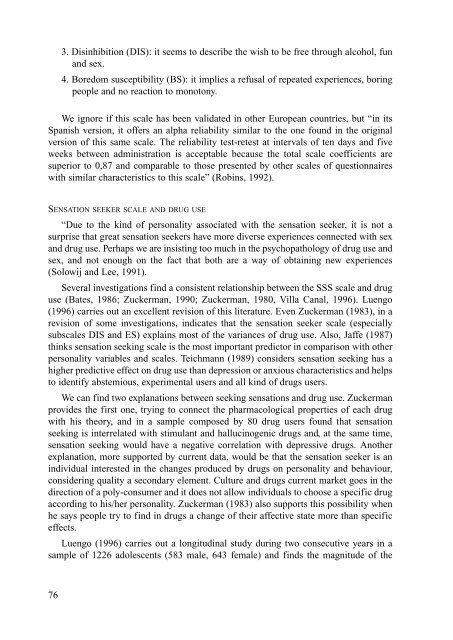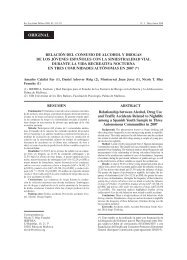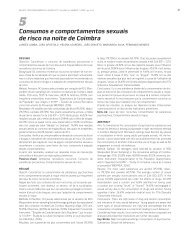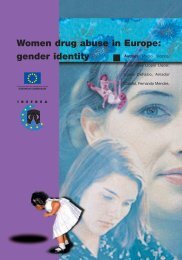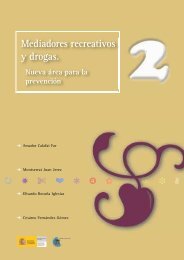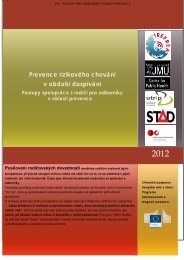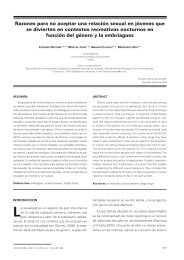Characteristics and social representation of ecstasy in Europe - Irefrea
Characteristics and social representation of ecstasy in Europe - Irefrea
Characteristics and social representation of ecstasy in Europe - Irefrea
You also want an ePaper? Increase the reach of your titles
YUMPU automatically turns print PDFs into web optimized ePapers that Google loves.
3. Dis<strong>in</strong>hibition (DIS): it seems to describe the wish to be free through alcohol, fun<strong>and</strong> sex.4. Boredom susceptibility (BS): it implies a refusal <strong>of</strong> repeated experiences, bor<strong>in</strong>gpeople <strong>and</strong> no reaction to monotony.We ignore if this scale has been validated <strong>in</strong> other <strong>Europe</strong>an countries, but “<strong>in</strong> itsSpanish version, it <strong>of</strong>fers an alpha reliability similar to the one found <strong>in</strong> the orig<strong>in</strong>alversion <strong>of</strong> this same scale. The reliability test-retest at <strong>in</strong>tervals <strong>of</strong> ten days <strong>and</strong> fiveweeks between adm<strong>in</strong>istration is acceptable because the total scale coefficients aresuperior to 0,87 <strong>and</strong> comparable to those presented by other scales <strong>of</strong> questionnaireswith similar characteristics to this scale” (Rob<strong>in</strong>s, 1992).SENSATION SEEKER SCALE AND DRUG USE“Due to the k<strong>in</strong>d <strong>of</strong> personality associated with the sensation seeker, it is not asurprise that great sensation seekers have more diverse experiences connected with sex<strong>and</strong> drug use. Perhaps we are <strong>in</strong>sist<strong>in</strong>g too much <strong>in</strong> the psychopathology <strong>of</strong> drug use <strong>and</strong>sex, <strong>and</strong> not enough on the fact that both are a way <strong>of</strong> obta<strong>in</strong><strong>in</strong>g new experiences(Solowij <strong>and</strong> Lee, 1991).Several <strong>in</strong>vestigations f<strong>in</strong>d a consistent relationship between the SSS scale <strong>and</strong> druguse (Bates, 1986; Zuckerman, 1990; Zuckerman, 1980, Villa Canal, 1996). Luengo(1996) carries out an excellent revision <strong>of</strong> this literature. Even Zuckerman (1983), <strong>in</strong> arevision <strong>of</strong> some <strong>in</strong>vestigations, <strong>in</strong>dicates that the sensation seeker scale (especiallysubscales DIS <strong>and</strong> ES) expla<strong>in</strong>s most <strong>of</strong> the variances <strong>of</strong> drug use. Also, Jaffe (1987)th<strong>in</strong>ks sensation seek<strong>in</strong>g scale is the most important predictor <strong>in</strong> comparison with otherpersonality variables <strong>and</strong> scales. Teichmann (1989) considers sensation seek<strong>in</strong>g has ahigher predictive effect on drug use than depression or anxious characteristics <strong>and</strong> helpsto identify abstemious, experimental users <strong>and</strong> all k<strong>in</strong>d <strong>of</strong> drugs users.We can f<strong>in</strong>d two explanations between seek<strong>in</strong>g sensations <strong>and</strong> drug use. Zuckermanprovides the first one, try<strong>in</strong>g to connect the pharmacological properties <strong>of</strong> each drugwith his theory, <strong>and</strong> <strong>in</strong> a sample composed by 80 drug users found that sensationseek<strong>in</strong>g is <strong>in</strong>terrelated with stimulant <strong>and</strong> halluc<strong>in</strong>ogenic drugs <strong>and</strong>, at the same time,sensation seek<strong>in</strong>g would have a negative correlation with depressive drugs. Anotherexplanation, more supported by current data, would be that the sensation seeker is an<strong>in</strong>dividual <strong>in</strong>terested <strong>in</strong> the changes produced by drugs on personality <strong>and</strong> behaviour,consider<strong>in</strong>g quality a secondary element. Culture <strong>and</strong> drugs current market goes <strong>in</strong> thedirection <strong>of</strong> a poly-consumer <strong>and</strong> it does not allow <strong>in</strong>dividuals to choose a specific drugaccord<strong>in</strong>g to his/her personality. Zuckerman (1983) also supports this possibility whenhe says people try to f<strong>in</strong>d <strong>in</strong> drugs a change <strong>of</strong> their affective state more than specificeffects.Luengo (1996) carries out a longitud<strong>in</strong>al study dur<strong>in</strong>g two consecutive years <strong>in</strong> asample <strong>of</strong> 1226 adolescents (583 male, 643 female) <strong>and</strong> f<strong>in</strong>ds the magnitude <strong>of</strong> the76


